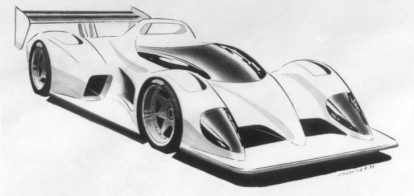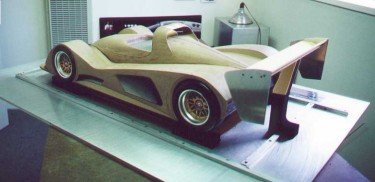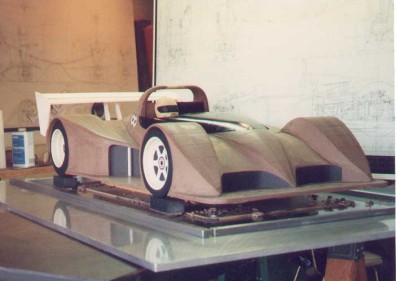 John
Hutnick is a consultant automotive designer with over 25 years of experience.
He has worked for firms as diverse as Hurst Performance Products and Calty
Design (Toyota's California design studio). In 1990 John was hired
by Dan Gurney's All American Racing to set up a design and modeling studio.
This department created sophisticated race car wind tunnel models allowing
aerodynamic theories to be turned into three dimensional shapes.
This program contributed to the Toyota domination of the IMSA GTP series.
John's other projects include a "world
car" for developing nations, consultation on a Chrysler sponsored NHRA
pro-stock drag race cars, and aerodynamic consultation for various sportscar
race teams.
John
Hutnick is a consultant automotive designer with over 25 years of experience.
He has worked for firms as diverse as Hurst Performance Products and Calty
Design (Toyota's California design studio). In 1990 John was hired
by Dan Gurney's All American Racing to set up a design and modeling studio.
This department created sophisticated race car wind tunnel models allowing
aerodynamic theories to be turned into three dimensional shapes.
This program contributed to the Toyota domination of the IMSA GTP series.
John's other projects include a "world
car" for developing nations, consultation on a Chrysler sponsored NHRA
pro-stock drag race cars, and aerodynamic consultation for various sportscar
race teams.
In 1993 John began the development of a World Sports Car chassis, the Hutnick JH-530.
 The
JH-530 was designed around a 107" wheelbase (183" long, 79" wide) utilizing
an aluminum honeycomb monocoque. A Katech small block Chevy V8 nestled
in between a rear tube assembly which mated to the gearbox/bellhousing.
The gearbox was to be either a March 5-speed or Hewland unit. The
4 corners were to have 14" discs with staggered 4 piston Brembo calipers.
The suspension consisted of unequal length double wishbones, bellcrank
pushrods, and double adjustable shocks.
The
JH-530 was designed around a 107" wheelbase (183" long, 79" wide) utilizing
an aluminum honeycomb monocoque. A Katech small block Chevy V8 nestled
in between a rear tube assembly which mated to the gearbox/bellhousing.
The gearbox was to be either a March 5-speed or Hewland unit. The
4 corners were to have 14" discs with staggered 4 piston Brembo calipers.
The suspension consisted of unequal length double wishbones, bellcrank
pushrods, and double adjustable shocks.  Considering
that the JH-530 predates the new ground breaking Lola
B2K/10 by over seven years rings home the axiom, "There are no new
ideas in racing". John planned on adjustable length, flat bottomed,
splitters at front. The initial IMSA WSC chassis rules were relatively
prohibitive and front venturi tunnels, as are now envouge, were forbidden.
Considering
that the JH-530 predates the new ground breaking Lola
B2K/10 by over seven years rings home the axiom, "There are no new
ideas in racing". John planned on adjustable length, flat bottomed,
splitters at front. The initial IMSA WSC chassis rules were relatively
prohibitive and front venturi tunnels, as are now envouge, were forbidden.
Aero. numbers were calculated, and it was thought that at 180 mph around 4500 lbs. of downforce could be generated. A lift-to-drag ratio of 4:1 was estimated. Coefficient of drag was a relatively high .55+. John indicates that the sidepod design is what contributed to the high coefficient of drag. A full wind tunnel program was considered utilizing the Ohio State wind tunnel.
Alas the expected monies didn't surface and the ideas didn't extrapolate beyond what is seen here. John is currently busy working on designs for a Pre-war styled, V-12 engined, limited edition, coachbuilt custom car.
